The Famous RV-10 "Hot Tunnel" issue
I just wanted to write this up to provide some background info on the
issue of excess heat in the tunnel area, and combine a bit of the info
that's currently going around. Thanks for some of this info needs
to go to many various people, but especially Dean and Bob from
Nebraska, and Scott Schmidt who I stole some of these photos from, and
Randy for a couple of the ideas he originally gave me.
First, the issue: Some
builders are seeing some very high temperatures in their tunnel area.
Rumor has it that it may have even led to a vapor lock issue, as
the tunnel is the area where all the fuel lines pass through. It
is not an issue for every builder, but this may be for a couple of
reasons... A) The earliest builders had the AWI exhaust, not the
Vetterman. and B) At least one of the earliest builders, Randy
#40006, had a blast tube on his fuel pump that may have helped cool the
heater box area. It is also not an issue for every builder with
the newer exhaust, as some of us have tried to take some logical steps
to prevent the problem in the first place. Those will be listed
below.
Van's did come up with a Hot Tunnel Service Bulletin on this issue, that should be read to help get some good ideas as well.
Theories:
- The tunnel heat issue could be caused by a variety of factors...
- Heat radiated from the exhaust stacks passing by the lower firewall
- Heat being blown into the tunnel through less-than-ideal sealing of the heater control boxes
- The heater control boxes could be heated by the hot air from the heat muff, and be conducting it to the firewall.
- General heat from the radiant exhaust just heating the firewall area
- Heat from the exhaust gasses passing over the lower tunnel skin
Here's a few photos of the exhaust and how it exits the cowl near the
firewall. You can get an idea of why some of the radiant heat
concepts came about. The exhaust tailpipes pass fairly close to
the firewall, and the gasses wouldn't be too awful far from the skin.
It is my opinion only though, that the gas temperature coming out
of the tailpipes, being close to the lower fuse skin, is probably not
one of the biggest factors. I may be wrong, and some of the
ceramic ideas presented below may or may not help...or could even
possibly make the situation worse from the exiting temperature
perspective.
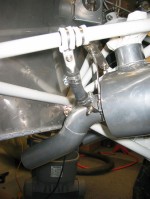
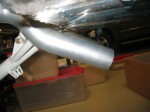
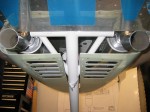
Here is a photo that shows the layout of the heater control boxes on
the firewall. When the valves are shut, hot air will be pumped into the
valve, but blow out the center area between the valves.
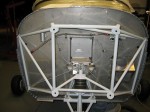
Possible solutions:
Here I'll try to give some pointers for possible solutions.
Remember that all of them may have some merit. Many of them
may also have drawbacks. Since this is free info, it's up to you
to decide.
- Insulate your firewall and tunnel area:
I can't think of any reason NOT to insulate your tunnel area and
firewall, other than the very minor reason that some people always seem
to give...weight. It won't hurt, from a sound-deadening point of
view, and in my personal opinion, may help a lot from a temperature
point of view. I insulated mine before first flight, so I can't
claim that it "changed my temps by 20 degrees" or anything like that.
I do feel, however, that it probably helps keep some of these
temps down. I got my insulation from Abby at Flightline Interiors.
It's pretty cool stuff, and is spongy feeling, yet fiberous, and
cuts and stays in shape real well. I didn't do anything to the
cut edges. It's "glued" to the firewall and tunnel with red RTV.
One idea that I haven't yet done, and may possibly do some day down the
road, is use similar insulation around my fuel lines in the tunnel,
just to help prevent not only the tunnel from heating, but the fuel
lines from heating from tunnel heat. There are many other types
of insulation that may work well, but I'm liking this stuff personally.
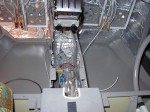
- Baffle and Seal your heater control boxes: I
haven't yet done this one, and I don't personally feel a ton of leakage
in flight, but Dean from Nebraska had the good sense to do a good deep
investigation as to the mechanics involved in these leaking valves.
In short, air being blown into one valve, when the valve is
closed, can be leaking under the shut valve (fixed by the small
air dam added on the inlet side...note that it hasn't been determined
if this may cause that air dam to soak up additional heat or not, but
it may very well help). Air can also be blown through
the valve when shut, and be blowing through the gaps in the hinge on
the opposite valve. This is easily fixed with some red RTV, and I
can't see any possible downside to this fix as long as you make sure
the valve operates properly.
Bob's great drawing of this concept

Dean's great photos of his modification
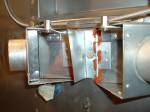
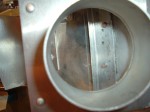
Here's Dean's original Post:
"I wanted to pass on a suggestion for those looking to keep their
RV 10
TUNNEL cool. Take your Black & Decker Wet vac and hook the hose to
the blower/discharge air. Then place the hose over one of the heat
vents on the firewall simulating hot air blowing into the cabin. Close
the vents and see if air is still entering the cabin with the vents
shut and the wet vac blowing air into the vent on the firewall side.
What we discovered was alot of air was entering the OPPOSITE vent when
both were closed. The air was coming in under the hinge on the vent
door. When I placed a small aluminum divider between the air vents on
the firewall the air ceased leaking into the cabin tunnel. After
playing with a few DEFLECTOR designs, I used the inside mounting bolt
on the vent box to hold a deflector in place and then also put an 1/8
inch deflector inside the vent box so air could not sneak under the
front of the vent door. This should solve the problem with HOT air
entering the Tunnel with the vents CLOSED. There still may be a Radiant
heat problem but insulation on the firewall and tunnel floor and
silicone between the firewall and vent box helps for Radiant heat.
Dean
40449"
- General heating of the Heater control boxes: It
was my opinion, after reading from some good "expert" posters on the
VAF site, like Vic, that this could be a major source of the heat.
Additionally, the fact that Randy didn't have a problem, and he
had a blast tube by his fuel pump, prompted me to use this idea on my
plane. The concept is, if you have heat going to those heater
boxes all the time, the boxes will get hot....duh! But then, the
hot boxes can conduct heat to the fuselage wall, which conducts to the
tunnel. seemed very reasonable. So, I did 2 things.
One of them was to install a blast tube from the Right rear baffle that
blows onto the heater control box area. It will force cooler air
to cool the boxes, and may also blow that hot air and motivate it to
keep moving out of the cowl. It is *possible* that because this
air in my installation isn't being blown directly downward, that it
could either be not ideal, or could be positioning some of that warmed
air somewhere else. I haven't seen anything that indicates a big
problem though. And it should be noted that I don't feel that I
personally have a tunnel heat problem. I can touch my bare toes
to the tunnel wall near the rudder pedals and not get super hot. The
blast tube is made with 1.25" SCAT, and a SCAT flange installed on the
baffle. I happened to have a ton of this SCAT tube around that I
didn't need, so I went with that size. If I was buying brand new,
I would have used 1", as I don't think it's wise to waste any more air
than necessary. The other fix in these 2 photos is that I took
some 1/8" silicone baffle gasket material, and made gaskets behing the
heater control boxes, and then RTV'd them into place with red RTV.
I used the silicone material because I couldn't guarantee that I
knew how hot they would get. Early on, Vic had the idea of
phenolic material, but I found that only very limited lower temp
capabilities....surprisingly low. The Silicone material was good
up to something like 550 degrees F, that and I happened to already own
some. I can't think of any possible downside to doing this little
fix with the gasket.
A photo of my blast tube
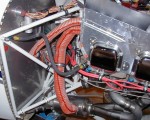
A photo of my gasketed control boxes
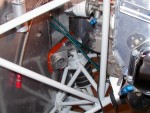
Additional Possible Solution Components:
Different Exhaust: Some
have suggested that either the AWI or the Forsling exhaust might at
least provide a different situation. I don't personally see these
as great "solutions" to the problem, because I don't personally see the
problem as that big. That said, if you're buying an engine and
NOT going with the whole FWF kit, you may want to explore the Forsling
option. I know very little about it.
Ceramic Coatings on part of the exhaust:
Scott Schmidt did ceramic coating on his exhaust, and from what I
understand, it can significantly reduce inside-cowl temperatures.
Note that I'm absolutely no expert on this. It appears
that it helps keep the heat within the exhaust pipes better. I
can see this being both a help and a problem. It could help,
because it could lower the general inside-cowl temp. It could
hurt because now the exit temp of the air, right by the skin, could be
raised. Probably in the end, it could be both good and
bad...nobody yet knows. We'll just have to see. One concept I
thought of though is just possibly ceramic coating the lower extension
from the heat muffs rearward. At least that would cut the radiant
heat from the tailpipes by the firewall. If you do ceramic coat
your exhaust from cylinder to tailpipe, and the exit heat is an issue,
you may try exhaust extension tubes. This one one of the possible
"solutions" discussed early on in the problems history.
False floor added to tunnel:
I can see this one being kind of nice to do, at least for the
first 12" of tunnel. I don't know that it will be worth the
effort or not, but the only downside I can see is the time invested,
which may not be too bad, oh, and for those nit-pickers, the extra
couple of ounces. Basically, you'd just add another false floor
above the tunnel floor. This will require you to re-mount your
fuel pump, and fuel flow sender (if it's mounted there), and may cause
you to have to re-work some of your fuel valve stuff, depending on what
you did. If it helps the problem though, then it may be nice.
We'll have to wait to hear reports from those who have flown with
this mod.
Gills on the bottom of the tunnel or in various cowl areas:
Seeing some photos of the "gills" on the cowl, I am almost
inclined to think that this idea wouldn't be such a bad one, if I were
still building and could easily do the mod. You could increase
the airflow exiting the cowl, and that might help. I personally don't
like the idea of gills or vents on the tunnel floor area though.
I don't think the problem is that bad, and I'd rather keep that
area weather-tight if possible.
Vent fresh air through the tunnel:
Some have thought of pumping air from a NACA vent into the
tunnel. Then you'd have to have an exit area for it too. I
don't like this idea unless you use inside-cabin air, that would be
dry. I'd rather not expose the tunnel to the elements.
Y-Tube bypass of part of the heat muff air, and vent it to the heat boxes: I may have to re-read the SB,
but I'm thinking the concept is to split the feed INTO the heat muff,
and have some of the air pass through the muff (to help keep it from
getting too hot, and also allow hot air), and have the rest bypass the
muff and be used as blast cooling for the air control boxes.
This idea, if you can easily get the Y-Tubes, I think woudl be
EXCELLENT. The RV-10 has PLENTY of heat in the winter, even in
real cold weather. If you could Y-Tube it off and use some of
that air to cool the heater boxes, I think you'd be doing just great.
Just make sure you leave enough air flowing through the muff to
keep it cool. It could also be that just disconnecting the outlet
from the air boxes, and redirecting it down and out of the cowl, would
be an OK idea in the summer. I'd rather have a year-round fix
though if possible. The Y-Tube sounds great, and then if you need
to shut off the air in the winter to the blast cooling, you could just
pull out the Y and put in a straight union.
This isn't meant to be complete, to bash anyones ideas, or to promote
my own as "expert". I just want to give some background on the
problem, and potential fixes, both tested and untested, for the
builders. If you have other ideas, I'll be happy to incorporate
them here too. I personally don't have a tunnel heat "problem",
as I mentioned above. My "Fix" was the tunnel/firewall
insulation, the heat box gasket, and the blast tube on the heat boxes.
Those are all fairly cheap, fairly painless, and pretty easy to do.
It is perfect, maybe not. I may actually do the Y-tube
thing too, just to save myself the lost pressure from my baffle blast
tube. Finding the Y's may be a challenge, but I'm sure I can find
them. Ideally, I'd have a 2" inlet, a 2" outlet, and an
additional 1.25" outlet. That would be idea as best I can imagine.
Hope this helps.









